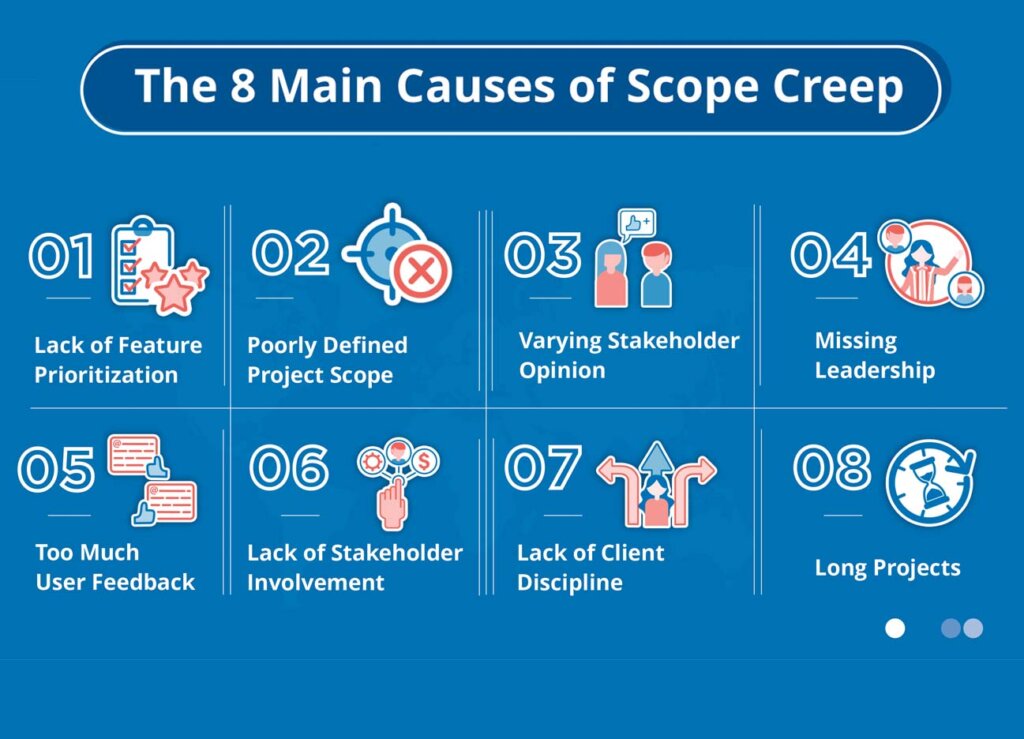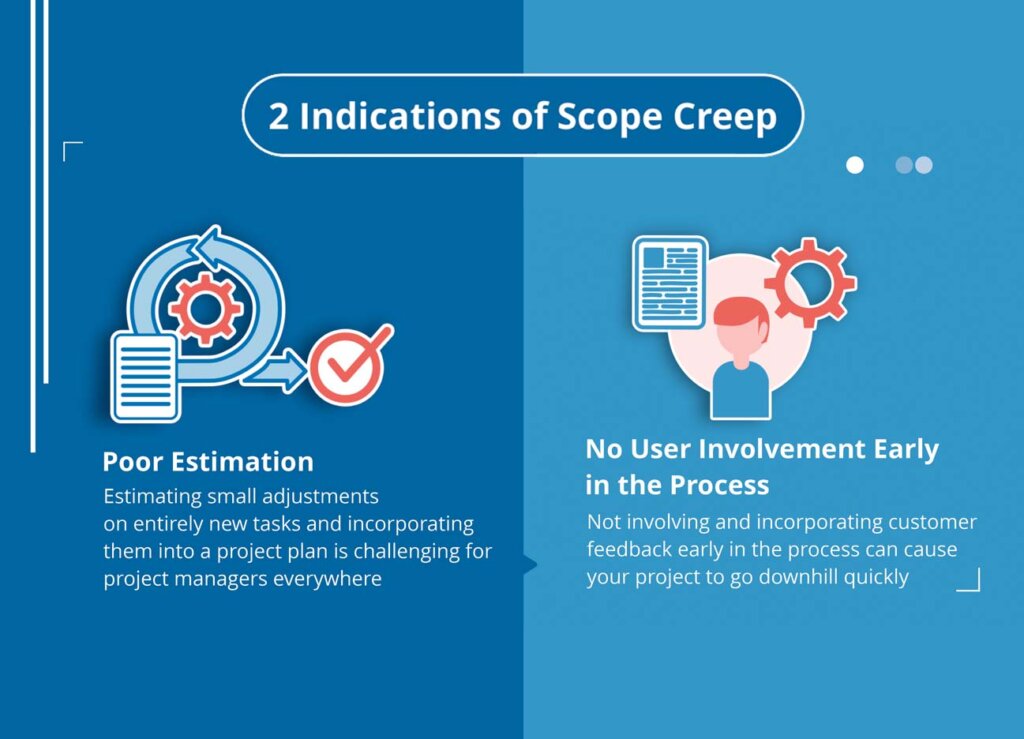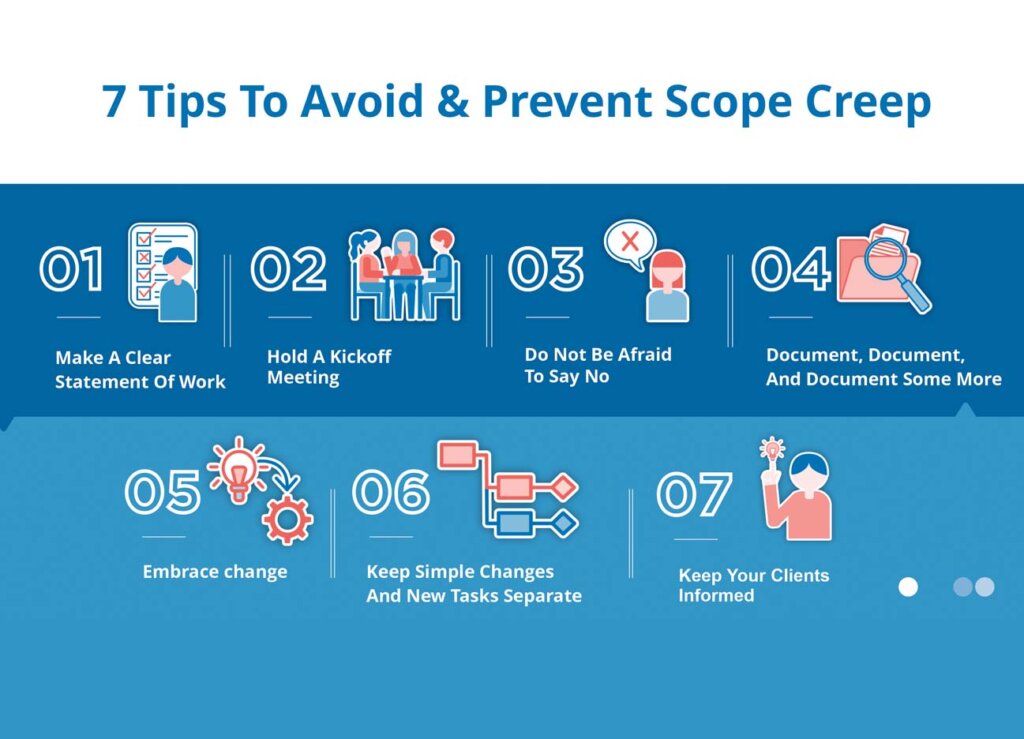Scope creep is one of the biggest culprits for delayed large projects. A lack of clear requirements, involving the wrong stakeholders, lack of documented functional and non-functional requirements, and poorly defined map process flows all contribute to scope creep.
Luckily, there are many strategies a project manager and all project stakeholders can put in place to manage scope creep. These include but are not limited to maintaining an open feedback loop with all stakeholders, gathering feedback early, working in sprints, and keeping detailed records of all changes within the set project scope.
Keep reading to learn more about what scope creep is, what the consequences are, and ways to avoid scope creep for your next successful projects.
What Is Scope Creep?
Scope creep causes projects to take longer than originally planned. Also known as requirement creep, there is no single agreed-upon definition of scope creep. Scope creep is when the original project’s scope expands with new features without taking into account time, budget, and project resources. As a result, it can lead to project delays or even project failure.
For example, your project scope demands building software with three key features within 3 months. At the end of the development, there are seven features, taking 8 months to build with massive overruns and unforeseen costs. These scope changes impact time, costs, and resources in a project, resulting in a change to the project scope, project schedule, and project deliverables.
Sources of scope creep can come from all angles, including the client, end-users, internal stakeholders, and external partners. It could rear its head with something as minuscule as a couple of project changes requested by the client or a lack of feature prioritization by internal stakeholders.
What Are the Consequences of Scope Creep?
There are endless consequences if scope creep turns up in a project. Some of the major effects of requirement creep include too much time spent on unapproved changes, cost overruns, changing project goals, hidden agendas, decreasing time and resources for approved tasks, and missing deadlines.
Coincidentally, one or more of these factors could result in employee attrition and furious clients, leading to a zero-sum game and ever-changing scope, even when using project management tools.
In the most extreme causes, scope creep can cause an entire project to be discontinued.
What Causes Scope Creep?
There are many major causes of scope creep in project management, including the following:

- Lack of feature prioritization.
- Poorly defined project scope.
- Varying stakeholder opinion.
- Missing leadership.
- Too much user feedback.
- Lack of stakeholder involvement.
- Lack of client discipline.
- Long projects.
Lack of Feature Prioritization
From the onset, requirement creep can be caused by failing to organize a project’s requirements from highest to lowest priority. This may create a disproportionate amount of time spent on lower priority tasks over higher priority tasks.
Poorly Defined Project Scope
Failing to outline and define project scope when the project begins could cause disruptions and iterations led by stakeholders and project managers, not the project plan itself. We highly recommend creating a project scope statement or similar mission statement document to clearly outline all project requirements, and sharing it with stakeholders and clients before the project starts.
Varying Stakeholder Opinion
In a typical project, input to the change control process can come from many key stakeholders, including project owners, engineers, designers, team members, and others. Stakeholders are those individuals who either are involved in the project or are affected by them. Generally, scope creeps caused by dissenting opinions can be addressed by reducing the number of stakeholders.
Missing Leadership
Leadership is integral to the success of any project. A leader who does not effectively communicate and manage scope and requirements is bound to have project direction turn a full 180 degrees. Any new requests for project features should have full buy-in from the managers and all stakeholders before starting work.
Too Much User Feedback
User feedback can often derail projects rather than move projects forward. Many amateur-level project management teams that fail to prioritize changes and differential deal breakers from “nice-to-have” changes often see project scope creep. Any customer feedback should be gathered and incorporated as early in the process as possible for managing scope creep later.
Lack of Stakeholder Involvement
One of the biggest causes of project scope creep is a lack of stakeholder involvement in defining a project’s objectives. These may include higher-level executives or another project team member who does not devote enough time to chime in on new features, which can force other project team members to make decisions on their own.
Lack of Client Discipline
One major cause of creep is not setting boundaries with the client early on in the project plan. If boundaries are not set, too many change requests are bound to occur, costing more time and resources than originally planned. It is critical to be firm with clients and maintain an open line of communication around potentially missed deadlines so everyone is on the same page.
Long Projects
In general, the longer the particular project is, the greater the likelihood of scope creep. When projects run over a long period, it gives stakeholders more time to change their minds and to come up with new requirements that may not fit within the overall project scope.
How To Identify Scope Creep
A few examples of how to minimize and limit scope creep include poor estimations and lacking user involvement early in the process.

Poor Estimation
Estimating small adjustments on entirely new tasks and incorporating them into a project plan is challenging for project managers everywhere. One way to prevent creep is to involve the whole team in the estimation process and to establish all tasks and deadlines upfront, preferably using project management software such as ClickUp.
No User Involvement Early in the Process
Especially true with software and product project management phases, not involving and incorporating customer feedback early in the process can cause your project to go downhill quickly. Early user validation confirms your project is on the correct track. If users are involved too late in the process and go against the grain, your entire project could be in jeopardy.
When using project management software like ClickUp, it is easy to identify a lack of user involvement early. Simply create sub-tasks for collecting feedback from users at regular stages of the project or upon each important milestone to stay on track.
Tips To Avoid and Prevent Scope Creep
In scope creep project management, there are a lot of actionable items a project manager and all stakeholders can do to limit creep, including the following:

- Make a clear statement of work.
- Hold a kickoff meeting.
- Do not be afraid to say no.
- Document, document, and document some more.
- Embrace change.
- Keep simple changes and new tasks separate.
- Keep your clients informed.
Make a Clear Statement of Work
A statement of work (SOW) is a project roadmap that contains a list of all tasks, due dates, and a description for each task, along with all assigned resources. It is a helpful tool to manage projects and make sure everyone is on the same page.
Remember, an SOW ensures that the client and project owner are aligned with all requirements, stating work exactly how the customer explained it and how project leaders, engineers, programmers, and other stakeholders understand and respond to new requests and additional project details. With a clear statement of work, expect a lower risk of scope creep.
Hold a Kickoff Meeting
Hold a kick-off meeting as soon as your detailed scope of work is finalized. This allows the opportunity for all project stakeholders to get together and review all requirements before starting work. This meeting should discuss roles, project milestones, allocated results, and reiterate the check-in process, whether they be daily or weekly meetings, to go over progress.
Do Not Be Afraid To Say No
Oftentimes, scope creep can occur due to a lack of discipline. With every client change request, be ready to present a case arguing against it or gather all requests and label them as part of a new project to start once the current work is complete.
Document, Document, and Document Some More
One major cause of scope creep is a lack of communication between the client and the project team, resulting in a poor change control process. With any change to the project scope, be sure to put the additional time and costs to be incurred in writing. If conducting meetings by phone, send a written recap to all people on the call.
Although creep cannot be eliminated, proper documentation can slow it down or extend deadlines as needed. This is one of the most effective ways of preventing requirement creep.
Embrace Change
Even with the best project managers and project teams, change is inevitable with every project. To limit scope creep with constant changes, it is important for a project manager to define detailed requirements, log changes, re-plan, collect feedback, and request additional resources to the project. If necessary, project managers can reduce scope creep, depending on the project’s objective.
Every change should keep a detailed record and every baseline should be kept up to date to help match project progress to resources. Detailed records should take into account new project overruns, resources, or tasks needed for completion. Too many requested changes should be led by a request for additional funding, either from internal stakeholders or the client.
Remember, any change can put a serious dent in budgets, task deadlines, and resources.
Keep Simple Changes and New Tasks Separate
When addressing scope creep, there is a difference between tweaking existing functionality and creating an entirely new function. Any new tasks outside of the project scope could be met with a new estimation of time, resources, and deadlines. If the new task or scope change is agreed upon, enter it into your project charter as part of a new or existing milestone.
Keep Your Clients Informed
To handle scope creep, clients should be informed of how decision-making is made with new change requests from the original scope. It is vital to document and agree upon all current project objectives and change requests with the client, as part of daily or weekly status meetings.
Frequently Asked Questions (FAQs) for How to Avoid Scope Creep
Final Thoughts on How to Avoid Scope Creep
One of the biggest factors in making or breaking a project is scope creep. Scope creep causes project overruns, wasted resources, and unclear expectations between the project owner, internal stakeholders, and the client. We highly recommend understanding scope creep, the causes, and how to avoid and prevent scope creep to move any project forward.
One project management software that could account for change management to limit requirement creep is ClickUp. ClickUp is a helpful project management tool for small to large-sized businesses managing projects across all industries from software engineering to design.

